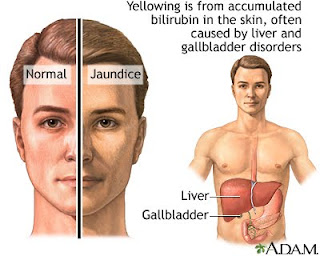How is the cause of jaundice diagnosed?
Many tests are available to determine the cause of jaundice, but the history and physical examination are important as well. History The history can suggest possible reasons for the jaundice. For example, heavy use of alcohol suggests alcoholic liver disease, whereas use of illegal, injectable drugs suggests viral hepatitis. Recent initiation of a new drug suggests drug-induced jaundice. Episodes of abdominal pain associated with jaundice suggests blockage of the bile ducts usually by gallstones.Physical examination
The most important part of the physical examination in a patient who is jaundiced is examination of the abdomen. Masses (tumors) in the abdomen suggest cancer infiltrating the liver (metastatic cancer) as the cause of the jaundice. An enlarged, firm liver suggests cirrhosis. A rock-hard, nodular liver suggests cancer within the liver.Blood tests
Measurement of bilirubin can be helpful in determining the causes of jaundice. Marked elevation of unconjugated bilirubin relative to the elevation of conjugated bilirubin in the blood suggests hemolysis (destruction of red blood cells). Marked elevation of liver tests (aspartate amino transferase or AST and alanine amino transferase or ALT) suggests inflammation of the liver (such as viral hepatitis). Elevation of other liver tests, for example, alkaline phosphatase, suggests disease or obstruction of the bile ducts.Ultrasonography
Ultrasonography is a simple, safe, and readily-available test that uses sound waves to examine the organs within the abdomen. Ultrasound examination of the abdomen may reveal gallstones, tumors in the liver or the pancreas, and dilated bile ducts due to obstruction (by gallstones or tumor).Computerized tomography (CT)
Computerized tomography (CT or CAT) are scans that use X-rays to examine the soft tissues of the abdomen. They are particularly good in identifying tumors in the liver and the pancreas and dilated bile ducts, though they are not as good as ultrasonography for identifying gallstones.Magnetic resonance imaging (MRI)
Magnetic resonance imaging (MRI) are scans that utilize magnetization of the body to examine the soft tissues of the abdomen. Like CT scans, they are good for identifying tumors and studying bile ducts. MRI scans can be modified to visualize the bile ducts better than CT scans (a procedure referred to as MR cholangiography), and, therefore, are better than CT for identifying the cause and location of bile duct obstruction.Endoscopic retrograde cholangiopancreatography (ERCP) and endoscopic ultrasound
Endoscopic retrograde cholangiopancreatography (ERCP) provides the best means for examining the bile duct. For ERCP, an endoscope is swallowed by the patient after he or she has been sedated. The endoscope is a flexible, fiberoptic tube approximately four feet in length with a light and camera on its tip. The tip of the endoscope is passed down the esophagus, through the stomach, and into the duodenum where the main bile duct enters the intestine. A thin tube is passed through the endoscope and into the bile duct, and the duct is filled with X-ray contrast solution. An X-ray is taken that clearly demonstrates the contrast-filled bile ducts. ERCP is particularly good at demonstrating the cause and location of obstruction within the bile ducts. A major advantage of ERCP is that diagnostic and therapeutic procedures can be done at the same time as the X-rays. For example, if gallstones are found in the bile ducts, they can be removed. Stents can be placed in the bile ducts to relieve the obstruction caused by scarring or tumors. Biopsies of tumors can be obtained. Ultrasonography can be combined with ERCP by using a specialized endoscope capable of performing ultrasound scanning. Endoscopic ultrasound is an excellent technique for diagnosing small gallstones in the gallbladder and bile ducts that may be missed by other diagnostic tests such as ultrasound, CT, and MRI. It also is the best means of examining the pancreas for tumors and can facilitate biopsy through the endoscope of tumors within the pancreas.Liver biopsy
Biopsy of the liver provides a small piece of tissue from the liver for examination under the microscope. The biopsy most commonly is done with a long needle after local injection of the skin of the abdomen overlying the liver with an anesthetic agent. The needle passes through the skin and into the liver, cutting off a small piece of liver tissue. When the needle is withdrawn, the piece of liver comes with it. Liver biopsy is particularly good for diagnosing inflammation of the liver and bile ducts, cirrhosis, cancer, and fatty liver.What is the treatment for jaundice?
With the exception of the treatments for specific causes of jaundice mentioned previously, the treatment of jaundice usually requires a diagnosis of the specific cause of the jaundice, and treatment is directed at the specific cause, for example, removal of a gallstone blocking the bile duct.NextWhat diseases cause jaundice?



